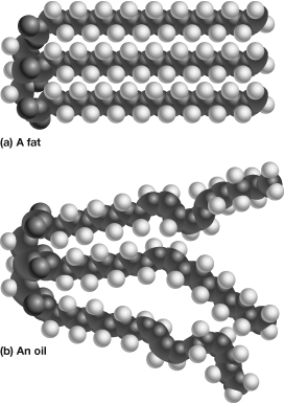A) Glucose
B) Lactose
C) Water
D) Fructose
Correct Answer

verified
Correct Answer
verified
Multiple Choice
Which type of lipid is most important in biological membranes?
A) Wax
B) Fat
C) Phospholipid
D) Steroid
E) Oil
Correct Answer

verified
Correct Answer
verified
Multiple Choice
As shown in this figure, the top triglyceride (a) has , whereas the bottom triglyceride (b) has _. 
A) no double bonds and is saturated; double and/or triple bonds and is unsaturated
B) double bonds and is saturated; no double and/or triple bonds and is unsaturated
C) no double bonds and is unsaturated; double and/or triple bonds and is saturated
D) double bonds and is unsaturated; no double and/or triple bonds and is saturated
Correct Answer

verified
Correct Answer
verified
Multiple Choice
The group of biological molecules that are most diverse in function is
A) lipids.
B) carbohydrates.
C) proteins.
D) nucleic acids.
Correct Answer

verified
Correct Answer
verified
Multiple Choice
The specific function of a protein is determined by the
A) hydrophilic head attached to the hydrophobic tail.
B) exact sequence of amino acids.
C) number of peptide bonds it contains.
D) number of disulfide bonds.
E) fatty acids that are joined together in the polypeptide.
Correct Answer

verified
Correct Answer
verified
Short Answer
Fatty acids that contain double- bonded carbon atoms are called .
Correct Answer

verified
Correct Answer
verified
Multiple Choice
Dehydration synthesis involves the removal of a hydrogen ion and a hydroxyl ion. What happens next?
A) The hydrogen ion becomes an isotope.
B) The hydrogen and hydroxyl ions combine to form water.
C) A polysaccharide is released from a monosaccharide.
D) A large polymer is split apart into small monomers.
Correct Answer

verified
Correct Answer
verified
Multiple Choice
All of the following lipids or lipid components are hydrophobic EXCEPT
A) unsaturated fats.
B) fatty acid tails.
C) fatty acid heads.
D) waxes.
E) saturated fats.
Correct Answer

verified
Correct Answer
verified
True/False
Functional groups determine the characteristics and chemical reactivity of organic molecules.
Correct Answer

verified
Correct Answer
verified
Multiple Choice
The fat substitute Olestra contains a sucrose backbone with six to eight fatty acids attached. How is this different from a naturally occurring fat?
A) Naturally occurring fats contain a glycerol and three fatty acids.
B) It isn't; Olestra and natural fats have the same structure, just different tastes.
C) Naturally occurring fats contain a sucrose backbone and three fatty acid chains.
D) Naturally occurring fats contain a glycerol, two fatty acids, and a phosphate group.
Correct Answer

verified
Correct Answer
verified
Multiple Choice
Suppose you have discovered a new virus and have isolated its nucleic acids. What feature could you look for to determine whether the nucleic acids of this virus are RNA or DNA?
A) If it is RNA, there will be no adenine.
B) If is RNA, it will contain deoxyribose.
C) If it is RNA, it will contain ribose.
D) If it is DNA, the virus will not contain proteins.
Correct Answer

verified
Correct Answer
verified
Multiple Choice
Lard is a solid fat at room temperature. What does this tell you about the triglycerides in lard?
A) The fats in lard are mostly phospholipids.
B) Lard is composed of unsaturated fats.
C) The fats in lard are not organic molecules.
D) Lard is composed of saturated fats.
Correct Answer

verified
Correct Answer
verified
Multiple Choice
Which of the following categories includes monosaccharide monomers?
A) Nucleic acids
B) Carbohydrates
C) Lipids
D) Proteins
Correct Answer

verified
Correct Answer
verified
Multiple Choice
Adenosine triphosphate (ATP) is an example of a(n)
A) protein.
B) carbohydrate.
C) nucleotide.
D) lipid.
E) inorganic molecule.
Correct Answer

verified
Correct Answer
verified
Multiple Choice
New government regulations require that foods containing trans fats be labeled appropriately. A trans fat is formed when food manufacturers turn liquid oils into solid fats by adding hydrogen to vegetable oils. This hydrogenation process produces a solid fat because adding the hydrogen
A) allows the fatty acid chains to pack together more tightly.
B) allows fats to form tertiary and quaternary structures.
C) forms a wax molecule.
D) causes a phospholipid to form.
Correct Answer

verified
Correct Answer
verified
Multiple Choice
Prions are known to cause
A) herpes.
B) mad cow disease.
C) sickle cell anemia.
D) the common cold.
Correct Answer

verified
Correct Answer
verified
Multiple Choice
Imagine that you have isolated a mysterious liquid from a sample of food. You add the liquid to a beaker of water and shake vigorously. After a few minutes, the water and the other liquid separate into two layers. To which class of biological molecules does the unknown liquid most likely belong?
A) Carbohydrates
B) Enzymes
C) Nucleic acids
D) Lipids
E) Proteins
Correct Answer

verified
Correct Answer
verified
Multiple Choice
What property of phospholipids makes them important in cell membranes?
A) They are part of DNA.
B) They are found only in animals.
C) They contain nucleic acids.
D) They have a polar end and a nonpolar end.
E) They are an important energy carrier molecule.
Correct Answer

verified
Correct Answer
verified
Multiple Choice
An example of a structural polysaccharide is
A) glycogen.
B) glucose.
C) starch.
D) cellulose.
E) maltose.
Correct Answer

verified
Correct Answer
verified
Short Answer
Important biological molecules that have a carbon backbone bonded to hydrogen atoms are considered to be .
Correct Answer

verified
Correct Answer
verified
Showing 41 - 60 of 98
Related Exams